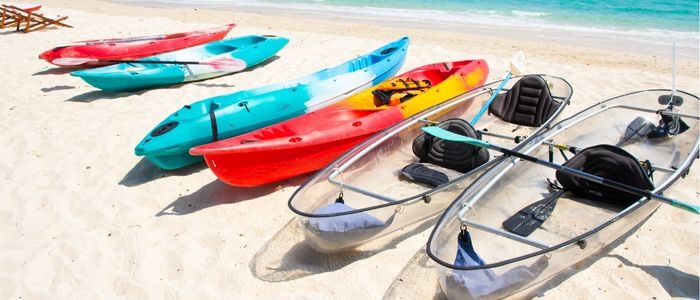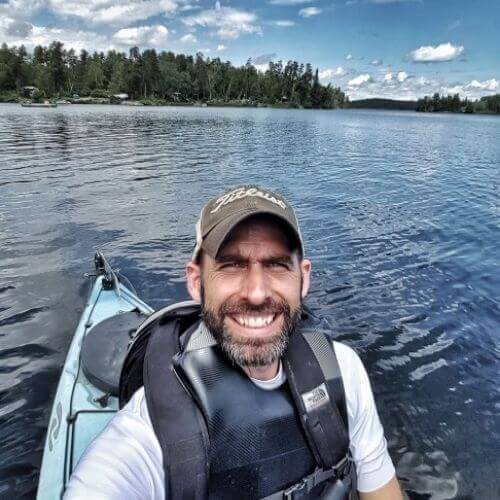
Many people wonder how far you can kayak in a day because kayaking is a really fun and relaxing sport. That’s the reason why I made this guide so that everyone would know how much you can paddle in one day.
The answer to this question depends on various things, and that is why there is no exact distance that you can complete in a day. In some situations, an average kayaker goes around 20 miles, and in other situations, an experienced kayaker can not go more than 10 miles per day. So, it all depends.
The average kayaking distance is around 20 miles per day, but if you want to go further, then it all depends upon your experience level and how much you train yourself for kayaking.
So, let’s discuss factors that affect the capability to cover distance while kayaking.
The size and type of kayak you use will greatly impact your ability to cover distance while kayaking.
If you are a beginner, the size of your kayak is probably going to be limited by your weight. If you are trying to put a short or inexperienced paddler in an X-large kayak, they might not be able to manage it, and they might tip over.
On the other hand, if you are an experienced paddler with some muscle mass, it’s worth considering getting a larger kayak to take advantage of its speed and stability.
The capacity of kayakers is also an important factor that affects their ability to cover distance while kayaking. A kayaker with a low capacity will have difficulty covering long distances, even if they are in the good physical condition and have a fast boat.
On the other hand, a high-capacity kayaker will be able to cover long distances even if they do not have a fast boat or are not in good physical condition.
The larger the capacity, the more weight they can carry. This includes themselves and any equipment they might have with them.
On-board weight is one of the most important factors affecting the capability to cover distance while kayaking. As a general rule, the more you weigh, the slower you will go. However, this is not always true. If you are paddling in calm waters with little wind and current, then your weight will not have as much of an effect on your speed.
However, if there are strong winds or currents in play, these factors will have much more impact on your speed and ability to move forward.
The best way to keep your kayak moving at a good pace is to keep your body in good shape. This means that you should be able to paddle for long distances without becoming fatigued or overly tired.
If this is something that you struggle with, then it might be time for you to consider hiring someone else to do it for you instead.
Weather conditions also affect the capability to cover distance while kayaking. Any kind of weather condition affects the kayak in different ways. For example, if it rains, there will be a lot of water on the ground, making it difficult for you to paddle through without getting your feet wet.
On the other hand, if there is a strong wind blowing, it can make it hard for you to stay upright in your kayak and may even cause you to get blown away from your destination.
Weather conditions also affect the capability to cover distance while kayaking. Any kind of weather condition affects the kayak in different ways. For example, if it rains, there will be a lot of water on the ground, making it difficult for you to paddle through without getting your feet wet. On the other hand, if there is a strong wind blowing, it can make it hard for you to stay upright in your kayak and may even cause you to get blown away from your destination.
Water condition is another factor affecting the capability to cover distance while kayaking.
For example, if the water is very shallow and there are many obstacles, it will be difficult for you to get far away from these obstacles. The water may also be too shallow for you to paddle out because there is no current to push you along with your kayak.
Since water is a fluid, it flows and does not stay still; this is what makes it an effective medium for travel and creates challenges for kayakers. The speed of the water current can vary depending on where you are in the river or lake, so if you are paddling upstream (against the current), you will have to work harder than if you were paddling downstream (with the current).
Furthermore, if there is a lot of turbulence in the water, for example, from rapids or waves, then this can also affect how fast your boat moves through the water.
The answer to this question depends on a lot of factors. The speed at which you can kayak depends on how hard you paddle, how big your boat is, what kind of waves you are paddling through (if any), and if there is a strong wind blowing in your direction.
An average kayaker can go about 3 miles per hour while paddling. This will increase if there is a strong headwind behind them or on a larger boat that allows them to sit lower in the water and thus use less energy for each stroke.
If your kayak doesn’t go faster or you cannot improve your kayaking performance, don’t worry. You are not alone; every intermediate kayaker comes to this stage, and improving your kayak’s performance is not that difficult.
There are many things that can affect the performance of a kayak.
The first thing to check is whether the paddle is suitable for the weight and height of the user. The paddles should be lightweight and durable so that they can be used for long periods without causing any strain on the arms or shoulders of the user.
The second thing to check is whether there are any leaks in your boat. If there is a leak in your boat, it will cause friction on the water’s surface, which results in reduced speed and efficiency while paddling through water bodies such as lakes and rivers, where most people love spending their time during summer vacations.
If the paddle is suitable for you according to your size and there is no leakage in your kayak, you will have to follow the below-given tips to go faster on your kayak.
These tips can help you improve your kayaking performance as well as your speed. The tips will make you a professional kayaker who can travel anywhere on the water.
Picking the right kayak is important for going faster on your kayak.
The first thing you should consider when picking a kayak is whether or not it’s made for speed. This may seem like an obvious choice, but some kayaks are designed to be more stable and have a smooth ride, which means they won’t go as fast as others.
You also need to think about what type of water you plan on paddling in because this will affect how fast your kayak can go. If you are going to be out on calm waters, you’ll want a kayak with a longer hull and narrow bow and stern.
If you are going to be on choppy waters, consider getting one with more rocker (curvature) in the bow and stern to cut through waves more easily.
A third thing that you should consider when picking a kayak is whether or not it has any features specifically designed for speed. Look at things like footrests and thigh braces; these help keep your body stable while paddling, which means that you will waste less energy keeping yourself balanced while trying to go fast.
The second tip is to make sure you are sitting straight in your kayak. Many people might don’t consider this, but it actually impacts your speed and performance.
It’s easy to get comfortable and slouch, but slouching in a kayak can cause you to sink lower in the boat. This will make it harder for you to paddle, leading to other problems, like water getting into your boat or an injury from falling out of the boat. Make sure you sit straight up with your legs extended and your backside firmly against the seat.
Your center of gravity is where all of your weight is focused. A lower center of gravity means that you will be more stable, and a stable person can perform better than others. So, try lowering your center of gravity while sitting in your kayak. It will eventually help you increase speed.
This can be done by moving forward in the boat and leaning back. It’s important to keep your weight centered in the boat, but you can tilt toward the back of the boat if you need to get over a wave or through a rough patch.
The lower you are, the more stable you will be on your kayak. Try to keep your center of gravity just a few inches above the waterline, and don’t bend your knees too much; this will make it easier for you to paddle without feeling like you are going to tip over.
If you want to go faster on your kayak, one of the easiest ways to do it is by customizing your kayak. Customizing your kayak means adjusting the length and width of your kayak to fit you perfectly. This means that when you are paddling, your body will be balanced and able to move quickly without feeling like it’s working too hard.
Customizing doesn’t mean that you have to spend thousands of dollars on a brand new boat. You can customize almost any kayak with a few simple adjustments.
The first thing you can do in your kayak is a sharp fin that can easily cut through the water without putting extra effort while stabilizing your kayak. After that, you can customize the hull area to be sharper to easily travel on water.
One of the biggest factors determining how fast you go on your kayak is your paddling technique. The better and more efficiently you paddle, the faster you will go.
The first thing to consider when adjusting your technique is whether or not you are using a double paddle or a single paddle. If you are using a double paddle, try switching from the regular grip (where both hands are on top of the paddle) to the underhand grip (where one hand is on top of the other). This will help increase your power and speed by using more muscle groups at once.
If you’re using a single paddle, try putting it in front of you instead of behind you to be closer to your body. This will allow for more efficient rotation of your body core and make it easier to stay balanced in the seat while paddling.
Improving your fitness can be a great way to help you go faster on your kayak. If you’re not fit enough, you may find it hard for you to keep up with others in your group or class.
So, to get better at kayaking, you must improve your fitness level to keep up with others and not be left behind. It also helps if you want to be able to paddle for longer periods without getting tired out easily.
So, now you know how far you can kayak in a day. It all depends on your technique and the environment you are kayaking in. And if you want to go far while kayaking, you can follow the tips given above. These tips will help you improve your kayaking technique while enhancing your experience.

Hey there kayak lovers! I’m Jay Schwartz, the author here at Kayak Guidance! You know water sports – you know me! My life is all about it. Kayaking, Paddleboarding, Fishing, Snorkeling and so much more. I love to share my passion and knowledge with all of you.

Hey there kayak lovers! I’m Jay Schwartz, the author here at Kayak Guidance! You know water sports – you know me! My life is all about it. Kayaking, Paddleboarding, Fishing, Snorkeling and so much more. I love to share my passion and knowledge with all of you.

Welcome to KayakGuidance.com! If you’re looking to have some fun outdoor water adventures, then you have come to the right place. We help our readers find the best kayaks and water related equipment to help you have the best time of your life whenever you are engaging in water activities.
This site is a participant in the Amazon services LLC associates program, an affiliate advertising program designed to provide a means for sites to earn advertising fees by advertising and linking to Amazon.com.